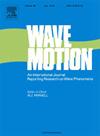提升等离子体物理:高阶非线性在具有过热离子的空间尘埃冲击波中的作用
IF 2.5
3区 物理与天体物理
Q2 ACOUSTICS
引用次数: 0
摘要
本文研究了在由惯性负尘埃粒子、麦克斯韦电子和超热离子组成的复杂等离子体介质中,极化力对尘埃声激波的高阶非线性和耗散效应。采用微扰方法,该研究导出了一阶和二阶电位和电场的分析描述,强调了这些高阶修正如何显着改变激波结构。分析表明,二阶电位引入负贡献,降低了整体波幅,而相关电场与一阶电场相反,导致影响能量输运和波稳定性的自我调节机制。数值评估显示了关键的等离子体参数,如极化强度、尘埃温度、离子电子密度比、粘度和超热度,如何影响相速度、非线性和冲击剖面。研究结果强调,包括高阶效应对于准确模拟与天体物理等离子体直接相关的实验室冲击动力学至关重要,特别是在行星环系统和宇宙尘埃环境中观察到的动力学,为复杂尘埃等离子体系统的能量耗散和波演化提供了更深入的了解。本文章由计算机程序翻译,如有差异,请以英文原文为准。
Elevating plasma physics: The role of higher-order nonlinearities in space dust shock waves with superthermal ions
This research explores the higher-order nonlinear and dissipative effects on dust acoustic shock waves in a complex plasma medium composed of inertial negative dust particles, Maxwellian electrons, and superthermal ions under the influence of polarization forces. Employing a perturbative approach, the research derives analytical descriptions of both first- and second-order potentials and electric fields, highlighting how these higher-order corrections significantly modify the shock wave structures. The analysis reveals that second-order potentials introduce negative contributions that reduce the overall wave amplitude, while the associated electric fields oppose the first-order fields, leading to self-regulating mechanisms that influence energy transport and wave stability. Numerical evaluations demonstrate how key plasma parameters, such as polarization strength, dust temperature, ion-to-electron density ratio, viscosity, and superthermality-affect phase velocity, nonlinearity, and shock profiles. The findings emphasize that including higher-order effects is crucial for accurately modeling shock dynamics in laboratory with direct relevance to astrophysical plasmas, notably the dynamics observed in planetary ring systems and cosmic dust environments, providing deeper insight into energy dissipation and wave evolution in complex dusty plasma systems.
求助全文
通过发布文献求助,成功后即可免费获取论文全文。
去求助
来源期刊

Wave Motion
物理-力学
CiteScore
4.10
自引率
8.30%
发文量
118
审稿时长
3 months
期刊介绍:
Wave Motion is devoted to the cross fertilization of ideas, and to stimulating interaction between workers in various research areas in which wave propagation phenomena play a dominant role. The description and analysis of wave propagation phenomena provides a unifying thread connecting diverse areas of engineering and the physical sciences such as acoustics, optics, geophysics, seismology, electromagnetic theory, solid and fluid mechanics.
The journal publishes papers on analytical, numerical and experimental methods. Papers that address fundamentally new topics in wave phenomena or develop wave propagation methods for solving direct and inverse problems are of interest to the journal.
 求助内容:
求助内容: 应助结果提醒方式:
应助结果提醒方式:


